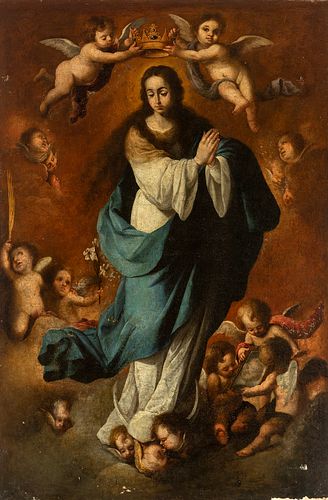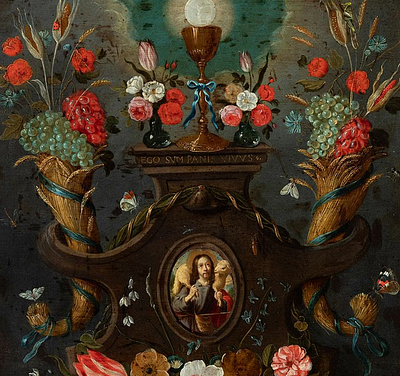Workshop of BARTOLOMÉ ESTEBAN MURILLO (Seville, 1617 - Cadiz, 1682). "Immaculate Conception". Oil on canvas. Re-tinted.
Lot 13
About Seller
Setdart Auction House
Carrer Aragó 346
Barcelona
Spain
Setdart Subastas was born in 2004 and is currently the first online art auction in Spain with solidity, prestige and reliability guaranteed by our more than 60,000 users. Setdart has a young, dynamic and enterprising team ready to successfully manage the purchase and sale of art works through custom...Read more
Estimate:
EUR€4,000 - EUR€6,000
$4,166.67 - $6,250
Absentee vs Live bid
Two ways to bid:
- Leave a max absentee bid and the platform will bid on your behalf up to your maximum bid during the live auction.
- Bid live during the auction and your bids will be submitted real-time to the auctioneer.
Bid Increments
| Price | Bid Increment |
|---|---|
| EUR€0 | EUR€10 |
| EUR€200 | EUR€25 |
| EUR€500 | EUR€50 |
| EUR€1,000 | EUR€100 |
| EUR€3,000 | EUR€200 |
| EUR€5,000 | EUR€500 |
| EUR€10,000 | EUR€1,000 |
| EUR€20,000 | EUR€2,000 |
| EUR€50,000 | EUR€5,000 |
About Auction
By Setdart Auction House
Sep 21, 2021
Set Reminder
2021-09-21 10:00:00
2021-09-21 10:00:00
America/New_York
Bidsquare
Bidsquare : 21st September - ARAS JÁUREGUI Private Collection - Old Masters, 19th & 20th Century
https://www.bidsquare.com/auctions/setdart-auction-house/21st-september---aras-j-uregui-private-collection---old-masters-19th-20th-century-7429
Setdart Auction House sofia@setdart.com
Setdart Auction House sofia@setdart.com
- Lot Description
Workshop of BARTOLOMÉ ESTEBAN MURILLO (Seville, 1617 - Cadiz, 1682). "Immaculate Conception". Oil on canvas. Re-tinted. It has restorations and repainting. Measurements: 159 x 105 cm. In this devotional work, the author follows the aesthetic precepts developed by Murillo, an example of this is the compositional similarity of this piece, with paintings of the same subject of the Sevillian author. There is a particular resemblance to the Immaculate Conception in the Oratory of San Felipe Neri, in which this circular composition can be seen, in which the angels are arranged next to the Virgin in such a way that she is inscribed in a border. The Virgin is crowned by two angels who hold a crown above her, in this particular case a golden crown, while in Murillo's work the crown is made up of the twelve stars, alluding to the 12 tribes of Israel, typical of the iconography of the Immaculate Conception. Medieval Christianity passionately debated the belief that Mary had been conceived without the stain of original sin. Some universities and corporations vowed to defend this privilege of the Mother of God, several centuries before the First Vatican Council defined the dogma of faith in 1854. At the end of the Middle Ages the need arose to give iconographic form to this idea, and the model of the Apocalyptic Woman of Saint John was taken, maintaining some elements and modifying others (the Apocalyptic Woman is pregnant, but not the Immaculate). The definitive image came to fruition in the 16th century, apparently in Spain. Following a Valencian tradition, the Jesuit Father Alberro had a vision of the Immaculate Conception and described it to the painter Juan de Juanes so that he could depict it as faithfully as possible. It is an evolved iconographic concept, sometimes associated with the theme of the Coronation of the Virgin. Mary is shown standing, dressed in a white tunic and blue cloak, her hands crossed on her chest, with the moon at her feet (in memory of Diana's chastity) and treading on the infernal serpent (symbol of her victory over Original Sin). Around her head, like a halo, she wears the twelve stars. Most of these images are accompanied in the painting by the Marian symbols of the litanies and psalms, such as the mystical rose, the palm tree, the cypress, the enclosed garden, the ark of Faith, the gate of Heaven, the ivory tower, the sun and moon, the sealed fountain, the cedar of Lebanon, and the spotless mirror, which in this particular case is held up by two little angels in a way that is somewhat reminiscent of the angel holding the mirror in Velázquez's Venus. Little is known of Murillo's childhood and youth, except that he lost his father in 1627 and his mother in 1628, for which reason he was taken into the care of his brother-in-law. Around 1635 he must have begun his apprenticeship as a painter, most likely with Juan del Castillo, who was married to a cousin of his. This working and artistic relationship lasted about six years, as was customary at the time. After his marriage in 1645 he embarked on what was to be a brilliant career that gradually made him the most famous and sought-after painter in Seville. The only trip he is known to have made is documented in 1658, when Murillo was in Madrid for several months. It is conceivable that while at court he kept in touch with the painters who lived there, such as Velázquez, Zurbarán and Cano, and that he had access to the collection of paintings in the Royal Palace, a magnificent subject of study for all the artists who passed through the court. Despite the few documentary references to his mature years, we know that he enjoyed a comfortable life, which enabled him to maintain a high standard of living and have several apprentices. The fact that he became the leading painter in the city, surpassing even Zurbarán in fame, motivated his desire to raise the artistic level of local painting.
- Shipping Info
-
In-house shipping available. Please inquire at admin@setdart.com.
-
- Buyer's Premium



 EUR
EUR CAD
CAD AUD
AUD GBP
GBP MXN
MXN HKD
HKD CNY
CNY MYR
MYR SEK
SEK SGD
SGD CHF
CHF THB
THB

















